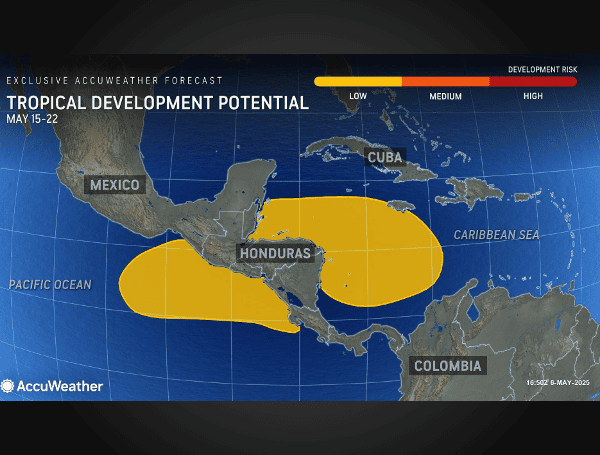While the official start of the Atlantic hurricane season isn’t until June 1, forecasters are already keeping a close eye on the Caribbean Sea for signs of early activity. The FOX Forecast Center is specifically monitoring the region during the second half of May for any potential tropical development, linking a possible threat to a phenomenon known as the Central American Gyre.
AccuWeather meteorologists also indicate that around the middle of May, a large, slow-spinning area in the atmosphere could develop somewhere around Central America, potentially overlapping with parts of the Caribbean and eastern Pacific Ocean.
This gyre can sometimes lay the groundwork for a tropical depression or tropical storm to take shape, and forecasters suggest this represents the best chance so far this year for the first named tropical storm of 2025 to develop in either the Caribbean or the eastern Pacific.
READ: DOJ: Operation Restore Justice Rescues 115 Children, 205 Arrests Nationwide, 5 In Central Florida
However, AccuWeather meteorologists currently assess the odds of development into a named storm as low.
The Central American Gyre is a sprawling area of low pressure that typically forms near or over Central America. It draws in moisture, often from the Pacific Ocean, and is primarily known as a heavy rain producer. Its impacts can extend hundreds of miles, leading to significant threats of torrential rainfall, flooding, and landslides across numerous countries in and around Central America.
“We’re starting to get into that season where we need to kind of keep an eye out [in the Caribbean],” said AccuWeather Lead Hurricane Expert Alex DaSilva. “At the very least, a wetter pattern down across Central America and then up into the Western Caribbean is expected.”
These tropical downpours could cause localized flooding across Central America, Jamaica, Cuba, and other islands across the western Caribbean. Some downpours could potentially reach South Florida.
Many computer model forecasts suggest that a Central American Gyre could develop in the region by late next week and into the following weekend. “There is consensus among the various computer model forecasts that a broad area of low pressure will develop from the Pacific across Central America to Colombia,” said FOX Weather Hurricane Specialist Bryan Norcross.
Within this large gyre, organized low-pressure centers can sometimes develop if water temperatures and upper-level winds become favorable for tropical organization. These systems can occasionally break away from the influence of Central America and form into a tropical depression or storm, most often occurring in the Eastern Pacific, the Bay of Campeche (southwestern Gulf), or the western Caribbean Sea, particularly before or after the official hurricane season.
Potential Track if System Develops
If the gyre does spawn a tropical depression or tropical storm in the Caribbean and it manages to organize, the most likely track, “Given the pattern,” DaSilva said, is northeastward. “I think the most likely is it would just cross, cross over Jamaica, Cuba, and then head out to sea,” he explained, adding, “Right now, it does not look like it would be heading towards the United States.”
Norcross also cautioned against anticipating a system tracking northward into the southern Gulf at this time, noting that some models like the GFS may show such development but lack support from other conventional or AI models in long-range forecasts.
READ: Caribbean Brewing? AccuWeather Issues First Tropical Risk Ahead Of Hurricane Season
Preseason Development Not Uncommon
Preseason tropical development is not uncommon in the Atlantic Basin. Outside of the traditional Atlantic hurricane season (June through November), May is the most common month for tropical storms to develop. Since 2015, there have only been four years when a tropical system did not spin up in May.
Over the past decade, tropical cyclones have developed before the June 1 start date in 8 of the last 10 hurricane seasons. This includes a seven-year streak from 2015 through 2021. Most recently, an unnamed subtropical storm in January 2023 was identified in a post-season analysis, kicking off that year’s activity early. Historically, since 1851, an average of about one tropical cyclone forms in the Atlantic between January 1 and May 31 every four years. The western Caribbean Sea, the Gulf, and the southeastern U.S. coast are the areas most favored for May development. Tropical Storm Bertha in 2020 made landfall in South Carolina in May, less than two weeks after Tropical Storm Arthur brushed the North Carolina coast.
Warming water in late spring can set the stage for this early development, particularly in the Caribbean, eastern Gulf, and western Atlantic. Additionally, a slow-moving cold front or a dip in the jet stream can reach far enough south and linger long enough for storms to form in these zones. According to DaSilva, a dip in the jet stream coming into the southeastern U.S. during the middle of May could be key to initiating the gyre itself, depending on its strength and southern reach. Reduced wind shear in the region could also contribute to potential development.
Gyres have played a role in recent activity; a gyre helped with the formation of Tropical Storm Alberto in June 2024, which made landfall in Mexico, and a gyre also developed near the western Caribbean in June 2023, though it did not lead to a named storm.
Early outlooks for the 2025 Atlantic hurricane season, such as the one released by Colorado State University in April predicting an above-average season with 17 named storms, 9 hurricanes, and 4 major hurricanes, suggest another busy season is likely. Any tropical development before June would only reinforce these early predictions.
As the official start of the Atlantic hurricane season approaches, forecasters will continue to monitor the Caribbean for any early signs of tropical activity linked to the potential development of the Central American Gyre.
“We’re coming out of the winter season, so we want people to start transitioning their mindset into tropical mode as we headed to the end of May, because there could be something lurking down there in the middle to late portions of the month,” DaSilva added.
Please make a small donation to the Tampa Free Press to help sustain independent journalism. Your contribution enables us to continue delivering high-quality, local, and national news coverage.
Connect with us: Follow the Tampa Free Press on Facebook and Twitter for breaking news and updates.
Sign up: Subscribe to our free newsletter for a curated selection of top stories delivered straight to your inbox.

